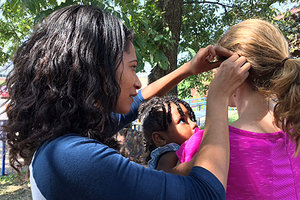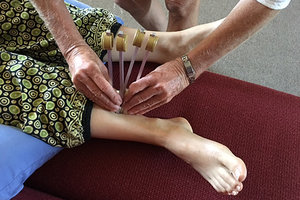Editor's Note: A thank you to the many that volunteered their time and services to the victims of the recent hurricanes, Harvey, Irma and Maria.
"Can you work on our shoulders too?"
The little girls aged around seven and nine, were fascinated, as I gave chair Shiatsu to a parent.
"Ladies," I smiled. "In fifteen minutes, OK?"
Five minutes later they bounced back again, just two of at least a dozen kids that surrounded me the day before as I worked outside in the leafy quad of the Unitarian Universalist Wildflower / Faith Presbyterian church campus in South Austin. It's not a shelter but a bustling, restoration/relocation/distribution/resource center run totally by volunteers organized by two local grassroot nonprofits — CounterBalanceATX and Guardians Gate.
Working mainly with African American families displaced by Hurricane Harvey's devastation of Beaumont and Port Arthur, organizers seek to create a personal, comforting range of services. Rooms surrounding the quad are filled to capacity with supplies, volunteers, food, advisory services, and FEMA.
Interviewed on NPR's local station KUT,1 CounterBalanceATX's co-founder and third year law student Fatima Mann said, "If you lost everything, what would you want the world to do? Straight Up: Stop and help me." The collective of non profits aim to change the way emergencies are handled by the "big organizations."
How this Involves Acupuncture, ABT & MT
 Stephanie Madden MACOM, performed mobile NADA in the quad. She applied magnets to a hurricane volunteer's ear, and advised her to roll her fingers over the magnets to help beat insomnia.
Part of that change involves us. Through Suzanne Rittenberry LAc, I made contact with the project so a variety of colleagues could offer acupuncture, ABT and MT sessions. I wanted a faster route beyond the time consuming Red Cross protocol.
Stephanie Madden MACOM, performed mobile NADA in the quad. She applied magnets to a hurricane volunteer's ear, and advised her to roll her fingers over the magnets to help beat insomnia.
Part of that change involves us. Through Suzanne Rittenberry LAc, I made contact with the project so a variety of colleagues could offer acupuncture, ABT and MT sessions. I wanted a faster route beyond the time consuming Red Cross protocol.
Enter Austin acupuncturist Claudia Voyles LAc, MAOM who rallied the Texas Acupuncture Response Network (TARN), I rallied AOBTA(r) colleagues, and AMTA colleagues. For the first week, several of us alternated three hour time slot sessions from 10 am until midnight.
We worked in the quiet haven of the sanctuary or outside in the bustling quad. Kids on tricycles zigzagged around us. Evacuee Jarvis Hunter told NPR/KUT it was like a "backyard BBQ." One day he set up as a DJ and blasted the quad with rap. A sense of community sure helps ease trauma.
I worked on a young grandmother who told me she waded shoulder high through water, holding her grandkids above her head. A second woman seeks help because her boss owed her a week's wages. Folks are directed to the relevant expert. JA Lazarus PhD, LAc, AOBTA(r)-CP described the setting as "an endless circle Bagua of linked support rooms, welcoming buildings, and ports of entry/exit for donation drop-offs."
Qigong and Foot Shiatsu
When a group of kids bounced up to my workchair, I decided to do my special "Fruit salad Qigong." We stretched, pretended we were fruit trees, then picked the fruit and chopped it up for salad. We made sweeping arcs for bananas, and peeling motions for oranges. Then I taught the kids collective foot Shiatsu seated in a circle on the ground.
The kids acquired skills I encouraged them to share with parents and families. Just a moment prompting a spontaneous solution for restless kids waiting to be enrolled in schools. All the evacuees I met had lost everything and intended dropping anchor in Austin longterm.
 Connie Randolph LAc, applied tuning forks to a hurricane volunteer's Spleen 6.
Tuning Forks & Ear Beads
Connie Randolph LAc, applied tuning forks to a hurricane volunteer's Spleen 6.
Tuning Forks & Ear Beads
Austin's Connie Randolph LAc, AOBTA(r) -CP, worked with tuning forks on evacuees and volunteers in the sanctuary itself. The kids were charmed by the harmonious ring as Connie worked the forks and applied them to Spleen 6 on our volunteer point person in the project, voice coach and teacher Melissa Grogan.
Modestly, Connie says the Acutonics, "can be as simple as just soothing the nervous system." She emphasizes the value of the technique in trauma work as "gentle, non-invasive, and non-intimidating." Connie said the tuning forks helped another woman "tap into and harmonize her own energies," after her trailer was destroyed by a falling tree. Vali Brinkman LAc sums it up. "Just a few needles ease stress, bring simplicity and elegance into a situation of chaos and complexity."
Claudia Voyles LAc MAOM and NADA instructor, takes a practical approach. "The main thing people need and get in disasters is safety, shelter, food, first aid, clothing, and we are integrating our medicine with that to help them restore, calm down, and begin to process what happened. I love having tools with acudetox and beads that do not require people to tell me a thing about what's going on. The world needs more NADA people able to treat trauma."
Tuina for the Red Cross
Paula Bruno PhD, AOBTA(r)- CP gave twenty Tuina sessions in five hours to Red Cross volunteers working in Austin's convention center. Like all of us she discovered tight shoulders and necks, and was able to line up volunteers in a row, apply a mix of tuina, gua-sha and cupping.
The volunteers had poured in from all over the U.S. Some had survived trauma themselves. Volunteering was like paying back. Paula was deeply touched when their concern turned to her. Had she eaten anything? Didn't she need rest?2
Here are some brief tips for those that are planning to volunteer:
- Be flexible and creative. Do brief ten minute sessions in the field, outdoors, wherever. Improvise. Find smaller shelters, often through interfaith groups.
- Let folks tell their stories.
- If someone balks at Asian Medicine or ABT – just say it will help energize and calm them. One evacuee looked askance at Connie's tuning forks. I said, "Ma'am, have you heard a harp being tuned? That's all this is. The forks tune your body!"
- Float where you're needed. Volunteer Kim Layne LAc, AOBTA(r)-CP (Tuina), sat and registered folks one morning where she noticed we had more volunteers than evacuees.
References
- Maas J. "No Shelter Here: Austin Group Tries to Provide Restoration from the Storm." KUT, Sept 11, 2017.
- Bruno P. "Tui Na in Service: Traditional Chinese Bodywork Therapy and Hurricane Harvey." Two Hearts Wellness, Sept 4, 2017.
Click here for more information about Pam Ferguson, Dipl. ABT (NCCAOM), AOBTA & GSD-CI, LMT.




